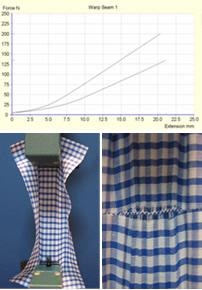Tinius Olsen and SDL Atlas participate and work within the Tasks groups at ASTM and the Working Groups at BSI, CEN and ISO meetings on the amendment and development of standards. Seaming properties and tensile strength are the key aspects to be measured in order to assess the fitness and longevity of the final garments.
Poor seam quality is one of the key reasons that affects the quality of the final product. Fabric slippage takes places when a woven fabric’s warp or weft yarns slide through the seam structure. This can be due to several factors.
The type of yarns employed, the loose weave or fabrication of a specific cloth, and the final finishing processes will influence the fabric’s fitness for a design and the selection of a seam structure suitable for the end use of the final product.
The following are the key standards for the European market:
- EN ISO 13934 -1;1999 Ravel Strip Strength
- EN ISO 13934 – 2;1999 Grab method for Tensile Strength
- EN ISO 13935 – 1;1999 method for Seam Strength Strip
- EN ISO 13935 – 2;1999 method for Seam Strength Grab method
At present, the aforementioned EN ISO standards are in a revision phase in order to take into account the wide variety of the latest Stretch fabrics. These methods also closely connect with EN ISO 13936 series of methods for assessing the threads in fabrics that can cause seam failure by moving and slip through a standard seam construction.
The EN ISO 13936 series of methods have already been revised by ISO to accommodate Stretch fabrics. Tinius Olsen often receives requests for customer support when the initial selection of method has not accommodated the scope of each method.
Textile Seam Testing
There are various methods available to help garment designers to assess the fabric quality through the use of a standard laboratory seam (Type 301 lockstitch seam) with a 12 mm seam bite. If the test result is negative, then necessary corrective actions need to be taken prior to the fabric is made up. This can be achieved by slightly modifying the weave and finishing specifications. If the results are trivial, then there can be change in the final selection of sewing thread types and seam construction.
Standard fabric test specimens of 400 x 100 mm are prepared with a seam at one of the specimen. The standard seam techniques depend on assessing paired data obtained from two tensile strength curves, as shown in Figure 1. The first curve is the fabric’s tensile strength, while the second curve represents the typical laboratory seam sewn across the center, thus allowing the same warp or weft threads to be pulled with or without a seam.

Figure 1. Tensile strength tests of fabric and fabric seams.
For Stretch fabrics, the specimens are 200 x 100 mm with a standard seam sewn across the center of the specimen. The method of performing this test has to be changed by avoiding the paired data approach and reverting to the physical measurement of the seam opening of the standard laboratory seam after stretching to a load specific to the end use and returning to a nominal force of 5 N.
Both techniques target the force at a 6 mm opening or the force needed to open the seam to 6 mm. Nevertheless, there are requests from some retailers for alternative seam bite and seam opening that represent the final seam type used during the production of garments. The range for seam bite is 5-12 mm and for seam opening is 2-6 mm. The following are the standards for seam testing:
- EN ISO 13936-1;2004 Slippage Resistance – Fixed Opening Method for standard fabrics
- EN ISO 13934-1:1999 + 13935-2:1999 + 13936-1:2004 for seam properties
- EN ISO 13936-2;2004 Slippage Resistance – Fixed Load Method for Stretch fabrics

This information has been sourced, reviewed and adapted from materials provided by Tinius Olsen.
For more information on this source, please visit Tinius Olsen.